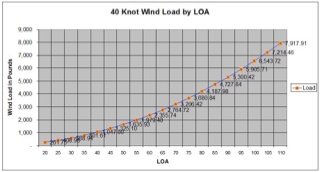MYTraveler
Guru
My boat displaces about 100,000 pounds and carries a 110 pound bruce with 440 feet of 5/16" HT chain. I made that selection when the boat was commissioned, 6 years ago. I remember concluding that, at the swl of the chain, the catenary effect with a 4 to 1 scope would keep the pull sufficiently horizontal that additional chain strength was not needed. My theory was that greater force would pull the anchor before the chain would fail. At the time, I had found and used a catenary calculator and other tools to conclude that additional chain strength (and weight) was not useful. Now, however, in looking at some on-line guides, I am thinking that I should have gone with at least 3/8" HT. That said, I have survived 40-knot winds without breaking the chain (or pulling/dragging the anchor). So, maybe I should focus on worrying about other things that could go wrong.

